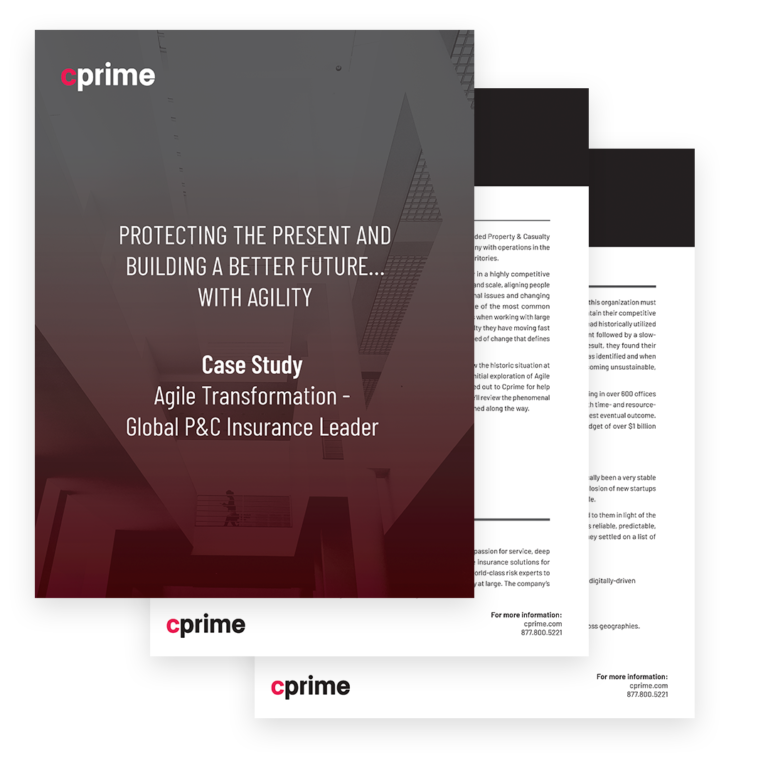The Client When a prestigious European technical university set out to build a moon robot,…
Case Study
Agile Transformation – Global P&C Insurance Leader
Company Details
Industry: Insurance
Company Size: 30,000 Employees
Location: Global
Products: Agile Team Training & SAFe® Training and Certifications
Cprime Services:
Executive Summary
This global P&C insurance leader always believed in continuous innovation, but due to the speed of business change, they found their development calendar extending years into the future. Their original process of development was unsustainable. With the help of Cprime consultants and trainers, the organization was able to meet their aggressive transformation goals.

Overview
Considering SAFe and Finding Cprime
This organization is a large, publicly-traded Property & Casualty (P&C) and commercial insurance company with operations in the U.S. and more than 50 countries and territories. Of course, being at the top, especially in a highly competitive industry, doesn’t come easy. At that size and scale, aligning people internally to effectively address external issues and changing market forces is a constant need. One of the most common challenges Cprime keeps coming across when working with large and successful companies is the difficulty they have moving fast enough to successfully pivot with the speed of change that defines modern business (and life). In the following case study, we will review the historic situation at this organization and what led to their initial exploration of Agile. We’ll cover why they reached out to Cprime for help and how we worked with them. Finally, we’ll review the phenomenal progress they’ve made and lessons learned along the way.
The Challenge
Over the Waterfall
This organization is a global P&C insurance leader because they have consistently combined a passion for service, deep experience, and exceptional financial strength with their desire to deliver the best possible insurance solutions for individuals, families, and businesses of all sizes. They make it a practice of encouraging their world-class risk experts to share their knowledge, insights, and experience for the benefit of their clients and the industry at large. The company’s core values and mission revolve around protecting the present and building a better future.
To make all of this possible at their current scale and in the existing global insurance environment, this organization must continuously strive to provide custom, high-end solutions for their agents and customers to maintain their competitive edge. And, while relentless improvement is part of their DNA, their solutions development teams had historically utilized a traditional Waterfall methodology. This method involves detailed and insular planning upfront followed by a slowand-steady development pace culminating in a massive release of the planned solution. As a result, they found their development calendar extending to many months, even years, between when a problem or need was identified and when the solution was deployed. In today’s fast-moving consumer environment, that process was becoming unsustainable, and was creating quantifiable business problems.
Of course, resolving the situation was no easy matter either. With over 30,000 employees operating in over 600 offices located in over 50 countries worldwide, any kind of significant organizational change would be both time and resource intensive. But, the desire was there, as was a willingness to do what was necessary to achieve the best eventual outcome. This commitment (even extending to the company’s ongoing technological transformation budget of over $1 billion annually) supported their decision to move forward with a pilot Agile transformation program.
Finding and Pursuing Agility
Paradoxically, although P&C insurance revolves around risk and unexpected events, it has historically been a very stable industry. The increased speed of change, dramatic evolution of customer expectations, and an explosion of new startups that knew how to navigate this new environment led this organization’s leadership to explore Agile. The House of Lean — a foundational component of the Scaled Agile Framework (SAFe®) — appealed to them in light of the paradigm shift the industry was undergoing. The House of Lean promotes a stable process that is reliable, predictable, and quality driven, which resonated with this organization. With these foundations in mind, they settled on a list of strategic and business imperatives:
Strategic Imperatives:
- Improve ease of doing business and operation effectiveness through integrated, data- and digitally-driven processes and systems.
- Establish a consistent experience for customers, agents, and employees.
- Develop and provide dynamic products and services to meet customer segment needs across geographies.
Business Imperatives:
- Improve speed to market and ability to respond to evolving customer needs and market changes in all 50 states.
- Digitize, enhance, and simplify experiences for both agents and customers and improve data accuracy.
- Allow agents, CSRs and business users to work holistically across a whole account.
- Develop micro-segmented products to provide appropriate coverage to the customer via a customized quote.
- Transform the quote proposal experience with content informed by micro-segmentation models and provide multiple quote options.
Standing in the way, however, were a number of challenges with legacy systems and gaps in their existing technology stack.
Technology Challenges
- The existing Virtual Desktop Infrastructure (VDI) could not support the development effort: For example, tools such as Docker did not work, there was significant lag, and desktops were unstable and unreliable.
- Highly restrictive security was applied to DevOps tooling, and it was housed external to the initiative, which would prevent the team from triaging and troubleshooting. Typically DevOps is more embedded within the organization’s project team, and “support” is less about continuous integration (CI) and continuous deployment (CD) configuration, and more about “is CI/CD online?”
- Highly restrictive and varying access to their Cloud would cause similar issues as experienced with access to DevOps Tooling.
- The use of an open source version of Kafka without enterprise support led to difficulties with administration and migration to production.
So, moving forward was not a decision the organization took lightly. But, once again, their commitment to improvement prevailed even in the face of these very real practical challenges.
Adopting SAFe® and Bringing in Cprime
Having thoroughly investigated Agile methodologies and settled on SAFe® as the framework that held the most promise for real sustainable change, the organization’s leadership gave the green light to a pilot program in the Personal Insurance (PI) line of business. PI wanted to address legacy technology limitations on their Agent Quote and Issuance System (AQIS), and they would use Agile development to do so.
PRS business and IT executives drafted goals for the initiative which evolved into a prioritized epic list. Prior to the first Program Increment (PI) planning session, recurring meetings were established with the product management (PM) team to decompose and refine the top three epics into a prioritized program backlog of 15 to 20 features. Those recurring PM meetings continue to this day, constantly creating, refining, and prioritizing features in the backlog.
The organization officially adopted SAFe® as their Agile methodology and partnered with Cprime to guide and coach them on their Agile transformation journey. Together, they designed PIs to incorporate five two-week sprints for a 10-week PI. The program participants quickly aligned to SAFe®’s cadence and synchronization approach, finding great value in regularly scheduled team and program-level events. Additionally, an in-person executive workshop led by Cprime trainers resulted in total buy-in at the executive level, a powerful motivator for organizational change.
The First Agile Release Train Pulls Out of the Station
The organization’s first Agile Release Train (ART) launched, adopting Essential SAFe® in the enterprise.
PI worked closely with Dan Teixeira, Northeast Delivery Director & Enterprise Agile Consultant for Cprime as this pilot program officially launched. Together, they took a uniquely aggressive multipronged approach to the initial training required for leadership and the members of the ART. Agreeing that there was a driving need among agents that justified the fastest possible transformation, both groups of stakeholders would be educated concurrently rather than focusing on leadership before moving on to the other teams, as is standard SAFe® practice. To support this effort, Cprime embedded an Agile Transformation Coach within the teams.
The ART consisted of three cross functional feature teams and one component team focused on the legacy system work. One feature team and the component team were co-located in NJ, the remaining teams were distributed across NJ, Mexico, and India.
At the program level, architects provided governance and design for this leading edge technology while executing in the build effort. Realizing that their contribution was not conducive to two week sprints, it was agreed that the architects would work in a Kanban approach based on the program backlog. Knowing what features were on the horizon, they were able to prioritize their own work in advance of the needs of the feature and component teams on the ART.
A year later, the foundations laid with that very first ART are still holding strong as the company continues to scale their use of Agile across teams and departments. But, what went on “behind the scenes” during those early days that truly cemented this success story?
The Solution
The Intersection of Culture and Production
As the leading champion of this entire initiative, the CIO was a driving force behind the pilot program’s success. He recalls,
“I had done a great deal of research into Agile prior to the initiative kickoff. The concepts and processes all seemed quite straight forward, and I was confident that my teams were up to the challenge.” – CIO
Confidence was so high, in fact, he was initially unsure what value an embedded Agile Coach could add. “I was pretty sure there was nothing new this person was going to be able to teach me,” he admits, “but I was wrong.” The PI team knew their stuff. They not only fully embraced the tenets of Agile and SAFe®, but they translated and expanded upon them for the benefit of the larger team. For example, they preached two “mantras” based on the Agile value of individuals and interactions over processes and tools:
- Building teams is not equal to hiring talent.
- Good leaders make others come alive!
Building off these concepts, they developed a seven step approach that would guide the larger organization, key appointees for Agile roles, and team members alike:
- Identify the raw talent in others and help them develop it
- Break down barriers of mistrust in the teams and build up the trust within leadership
- Draw out the contributions of those less extroverted
- Limit the overbearing of the Type A’s
- Encourage people to hold themselves accountable to meet commitments
- Always demonstrate fairness
- Inspire every individual to become their best, by setting the example in myself
Also recognizing that a major goal of Agile and SAFe® is to “shift quality left,” they asked teams to incorporate quality into every step while minimizing risks. They challenged them to automate all testing, and embrace CI/CD from the very start.
Despite the ideal cultural and practical backdrop the PI was building, however, it was in the implementation — where the rubber really meets the road — that any initial doubts about Cprime’s involvement were wholly resolved.
“Changing organizational culture and introducing a new way of doing business is a huge undertaking” – Transformation Leader
“Changing organizational culture and introducing a new way of doing business is a huge undertaking,” one stakeholder recalls, “and the task could have quickly become overwhelming. Progress could have ground to a halt. With the help of Cprime’s insight and direction, however, I was able to flesh out my own vision for the initiative and effectively implement SAFe® quickly across diverse and remotely located teams.”
He concludes, “we never would have met our aggressive transformation goals without Cprime.”
What Cprime Provided
Over the course of a 10-month engagement, the Agile transformation experts at Cprime offered all of the following:
- SAFe® certification trainings
- Cprime proprietary workshops
- In-person executive training
- Team and program event coaching
- Individual one-on-one guidance
Having these services customized to the organization’s unique circumstances and needs made them more effective and more enjoyable for everyone involved. Combined with the teams’ tremendous desire to learn and succeed, they quickly moved from a Waterfall mindset to “doing” Agile and “living SAFe®.”
The Results
So, where is the organization now along their Agile transformation journey? The CIO shared the following updates:
- We are maintaining alignment to the strategic vision by driving continuous refinement and prioritization of the program and team backlogs based on agent and customer feedback, revised business outlook, and strategic imperatives.
- We are continuously delivering using the SAFe® framework, with new features and fixes released regularly on an optimized ART cadence.
- Business and IT are working effectively together to deliver work iteratively each sprint.
- Early learnings through demos and established feedback loops provide insights from agents and customers regarding user experience expectations. This has helped to drive focus on real end-user needs, rather than the business-defined expectations our former Waterfall methodology relied on.
He has seen a number of positive impacts on his teams as well:
“As a CIO, I see that the entire team is super-engaged in the project at all times, so they’re more productive. For example, under the previous Waterfall process, BAs used to be very busy during requirements gathering while developers were an audience. Then, developers were very busy during coding and BAs were in support mode. Now, the entire team is fully engaged throughout the project. This is a game changer.
“There’s also more opportunity to help each other and teamwork has improved as a result. On projects where we have multiple teams working concurrently, we’ve often seen sprints where one team is struggling to finish their user stories and the other team is ahead. Since team members are cross-functional, the team that’s struggling can ask for help and members from the other team jump in. The Release Train Engineer can rearrange teams proactively as well to help avoid this situation when it is foreseeable. In the end, everyone is engaged and highly productive.”
He also relates a powerful example of the impact his team’s Agile transformation has had on the organization as a whole:
“During one project, we hired a design company to assist us with user experience (UX) design and workflows. Prototypes were developed and the team started implementing them. We then conducted a demo for our senior executives after two sprints of work. The UX and prototypes did not meet the senior executives’ expectations and we ended up needing to create totally new prototypes. On one hand, this taught us a powerful lesson regarding the need for alignment of
expectations between middle management and senior executives. However, the biggest save was that this was caught in the second sprint. If this had been a Waterfall project, we wouldn’t have developed the UX until 6 months down the road, and this would have cost the company millions of dollars, not to mention major project delays, impacting speed to market.”
Thus far, the Agile transformation at this organization has been a resounding success. Of course, an Agile transformation is a journey, not a destination. So, the journey continues. But, there’s no doubt that going Agile has set up this current global leader in P&C insurance to retain that position for many years to come.
If you’d like to see similar results for your organization, explore our flexible range of scaled Agile solutions.
About Cprime
Cprime is an industry-leading, full-service global consulting firm with a focus on providing integrated and innovative solutions around digital transformation, product, cloud, and technology. With over 20 years’ experience, we provide strategic and technical expertise to businesses across more than 50 industries. Our team of advisors and technical experts have the know-how to meet organizations where they are to develop actionable solutions and solve business challenges. We also collaborate with our expansive network of partners to design, deploy, and harmonize technology stacks across organizations. Our mission is to empower visionary business leaders and teams to reimagine the future of work to achieve better outcomes.
Want to share with a colleague? Download the PDF
